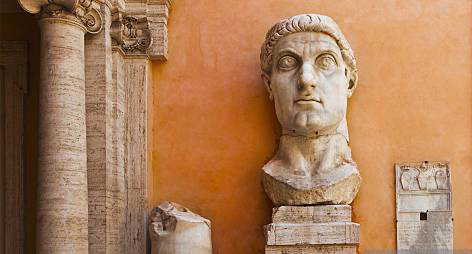Below, abridged translation from the first
volume of Karlheinz Deschner’s Kriminalgeschichte
des Christentums (Criminal History of Christianity)
Editor’s note: Constantine did not only wage war on the adepts of Hellenic culture but on the Aryans themselves, the blond Goths: he perpetrated massacres even against blond women and children. In this entry the behaviour of the Judaized Christians he empowered reminds me the saying, ‘The Jew is always either at your throat or at your feet’.
From the pacifist Church to the Church of the pater castrense
That prince, buried among the funeral steles of the apostles and sanctified by the Eastern Church—although among western heroes there is not lacking of the same genre: Charlemagne for example, was called a Saxon butcher—, that saint Constantine who never lost a battle, ‘man of war’ (Prete), the ‘personification of the perfect soldier’ (Seeck), fought countless wars and great campaigns, most of them ‘with a terrible hardness’ (Kornemann).
 In summer or autumn of 306 he waged war against the Bructeri, first in Roman territory and then invading them. In 310, again against the Bructeri, Constantine burns the villages and orders the dismemberment of the ringleaders. In 311, against the Franks; the chiefs of the tribes pay with life. In 314, against the Sarmatians, already vanquished by himself in the time of Galen, now deserving the title of ‘great slayer of the Sarmatians’ (sarmaticus maximus). In 315, against the Goths (gothicus maximus).
In summer or autumn of 306 he waged war against the Bructeri, first in Roman territory and then invading them. In 310, again against the Bructeri, Constantine burns the villages and orders the dismemberment of the ringleaders. In 311, against the Franks; the chiefs of the tribes pay with life. In 314, against the Sarmatians, already vanquished by himself in the time of Galen, now deserving the title of ‘great slayer of the Sarmatians’ (sarmaticus maximus). In 315, against the Goths (gothicus maximus).
In 320, his son Crispus defeated the Alamanni; in 332, it is he himself who again defeats the Sarmatians. All this is worth a rich booty and thousands of prisoners deported to Roman lands as slaves. In 323, he defeats the Goths and orders to burn all their allies alive. The survivors are also thrown into slavery; new title: ‘gothorum victor triumphator’. New foundation: the games ‘ludi gothici’, which are held every year from 4 to 9 February (after having founded the ‘frank games’).
During the last decades of his life, Constantine fought often in the Danubian regions, trying to make ‘land of a mission’ of them (Kraft), and inflicts on the Germans defeats that influenced even their religious history (Doerries). In 328, he subdues the Goths in Banat. In 329, Constantine II almost exterminated an army of Alamanni. In 332, father and son again crush the Goths in Marcianopolis; the number of deaths, including hunger and freezing (‘fame et frigore’, as the Anonymous Valesian says), was calculated in hundreds of thousands, not excepting women and children victims of the ‘Great Diaspora of the Goths’.
In the year 313, Constantine and Licinius enact their Edict of Tolerance; Christianity, once forbidden, becomes a licit religion (which from that moment hastens to declare all other religions unlawful), and from overnight comes the amazing metamorphosis of the pacifists into regimental chaplains! If before they faced everything, even martyrdom, as long as they did not provide the pagan service, now the need to kill seems obvious to them. The Church became the party of the predators from that moment on, it shared the direct and indirect responsibility of a millennium and a half of massacres.
Lactantius ‘was one of the first to enjoy, as favourite of the emperor, the new regime of alliance between the sword and the cross’ (Von Campenhausen); in other words, one of the first to change colours. In 314 he wrote a summary or epitome where he crossed out all the pacifist passages. The grateful writer corrects the dedication of his main work and begins to praise the war and legislative activity of the sovereign. It is then when Christianity happens to become a ‘bloody struggle between good and evil’ (Prete).
Thus Lactantius betrayed his own convictions, denying almost three centuries of pacifist tradition—and with him, in the background, the whole Church, obedient to the will of the emperor who had recognized and made her rich and influential, but who had no job for a pacifist and passive clergy, but for those who agreed to bless their weapons. And they have not stopped blessing them since then, or as Heine has written: ‘It was not only the clergy of Rome, but also the English, the Prussian; in a word, always the privileged priesthood associated with the caesars and their ilk, in the repression of the peoples’.
Modern theologians, who do not dare to deny in their entirety that bankruptcy of the doctrine of Jesus, speak of an ‘original sin’ of Christianity. With this they try to play down the importance of the event, as if remembering the story of the snake and the apple, as if the whole question were nothing more than ‘a small Edenic slip’. As if we did not speak of massacres perpetrated for millennia, now committed in the name of ‘the good news’, of the ‘religion of love’; massacres that now turn out to be fair, necessary and even excellent.
Thus a new theology is born, although wrapped in the terminological garb of the old woman to disguise it. And the new theology is not only political but also militaristic: now they speak of Ecclesia triumphans, of Ecclesia militans, of the theology of the emperor… or of all the emperors, at least of the Romans of Antiquity who brought their line back to Caesar, but much further on in reality.